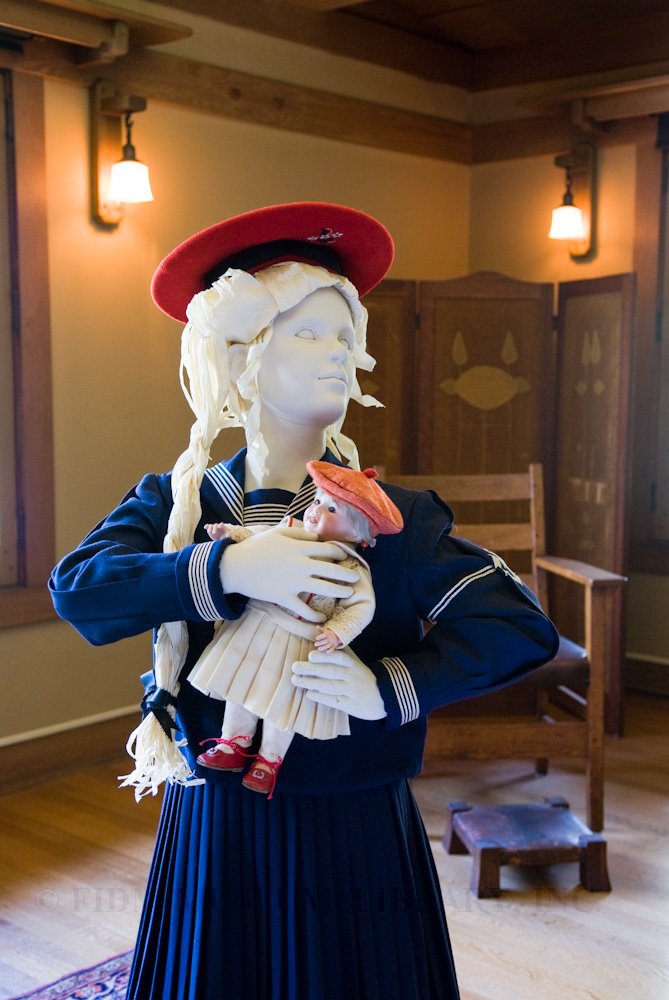Sailor suits
Beginning in the mid-nineteenth century, young boys and girls were often dressed in sailor suits. Worn as both school uniforms and everyday dress, the popularity of the style was sparked by this 1846 Winterhalter portrait of Albert Edward, Prince of Wales. About 5 years old when the portrait was painted, Albert Edward wears a scaled down version of the newly standardized white and blue uniform of the Royal Navy.1 Throughout the nineteenth century, the Royal Navy was the most powerful navy in the world, a symbol of the United Kingdom's colonial empire and position as a world power. By dressing Albert Edward and her other sons in naval uniforms, Queen Victoria indicated her aspirations for her children and her country. As royalty were the trend-setters of the day, the fashion for sailor suits soon spread across Europe and the United States. National versions of the sailor suit varied, depending on the specific naval uniform of individual countries. For boys, the sailor suit consisted of a middy-style top and either short or long trousers. By the 1870s, girls were wearing skirted sailor suits for school and play. Whether purchased ready-made or sewn at home, sailor suits for children closely resembled actual naval uniforms. In 1886, the U.S. Navy changed its regulations, declaring that the middy top would be worn untucked, and children followed suit. Trim, including chevrons, eagles, anchors and stars, also mimicked the symbols of rank worn on naval uniforms. An embroidery pattern in the September 1906 issue of The Ladies' Home Journal provided detailed instructions for embroidering eagles, anchors and stars on both girls' and boys' sailor suits. As shown in the image below, both accessories and toys were created with the sailor suit in mind.
 Sailor ensemble and beret 1905-10 Sailor ensemble: Museum Purchase 81.25.2A-C Hat: Gift of the Manlove Family 2006.870.77
Sailor ensemble and beret 1905-10 Sailor ensemble: Museum Purchase 81.25.2A-C Hat: Gift of the Manlove Family 2006.870.77
Unlike another style of dress for young boys, the Little Lord Fauntleroy suit, no widespread evidence suggests that children disliked wearing sailor suits. In fact, children might have enjoyed its distinct appearance (almost like a fancy dress costume) and its association with military might. For parents, the appeal of the sailor suit was probably in its versatility and durability. Usually made of washable, sturdy fabrics like wool serge, sailor suits allowed relative freedom of movement and could be easily cleaned. Depending on fabric and trim, sailor suits could also be appropriate for a variety of social situations. In May 1904, Harper's Bazaar called a sailor suit "the most serviceable all-around frock a girl can have."
 Girl's sailor (middy) top C. 1920 Gift of the Manlove Family 2006.870.69
Girl's sailor (middy) top C. 1920 Gift of the Manlove Family 2006.870.69
Probably due to their military origins, and thus an association with order, unified purpose and discipline, sailor suits were frequently worn as school uniforms. This red wool twill sailor top was probably worn as a gym uniform with the pair of black bloomers seen in this post. A movement to educate girls, rather than 'finish' them, emerged in the late nineteenth century. Games and athletics were an important part of the curriculum at schools with a more educational bent, and female students required appropriate dress. Sailor suits, when worn with bloomers, allowed freedom of movement while maintaining modesty. When found in museum collections, sailor suits worn as uniforms often bear labels naming the wearer. The FIDM Museum example bears a label reading "Ruth T. Manlove," a relative of the donors. Another label reads, "Bonnie Briar," which is probably the school Miss. Manlove attended.
Though full sailor suits were most commonly worn by children, elements of nautical style were absorbed into adult dress. Nautical influences, including blue and white stripes, square sailor collars and wide, loose trousers are enduring elements of spring and summer dress. A recent interpretation of these elements can be seen in the 2010 Chanel Resort collection. The most spectacular example of fashionable nautical dress in the FIDM Museum collection is probably the 1950s Norman Norell dress seen below. We featured this dress in a post last August; you can read more Norman Norell and his enduring interest in sailor styles here.
 Day dress Norman Norell for Traina-Norell 1951 Gift of Mrs. Clarissa Dyer 2003.794.4A-C 1
Day dress Norman Norell for Traina-Norell 1951 Gift of Mrs. Clarissa Dyer 2003.794.4A-C 1
Albert Edward became King Edward VII in 1901, after the death of his mother, Queen Victoria. His reign (1901-1910) is usually called the Edwardian Era, a distinct period in fashion history.
